Overview of the industrial revolution 4.0 and some impacts on sustainable business
The fourth industrial revolution (abbreviated as the industrial revolution 4.0) is in the
evolution phase and will affect all socio-economic sectors. This is an unprecedented
revolution in human history, and this new production revolution is expected to have a
powerful impact on all nations, governments, businesses and citizens around the globe, and at
the same time alter completely production and administration systems, including sustainable
business.
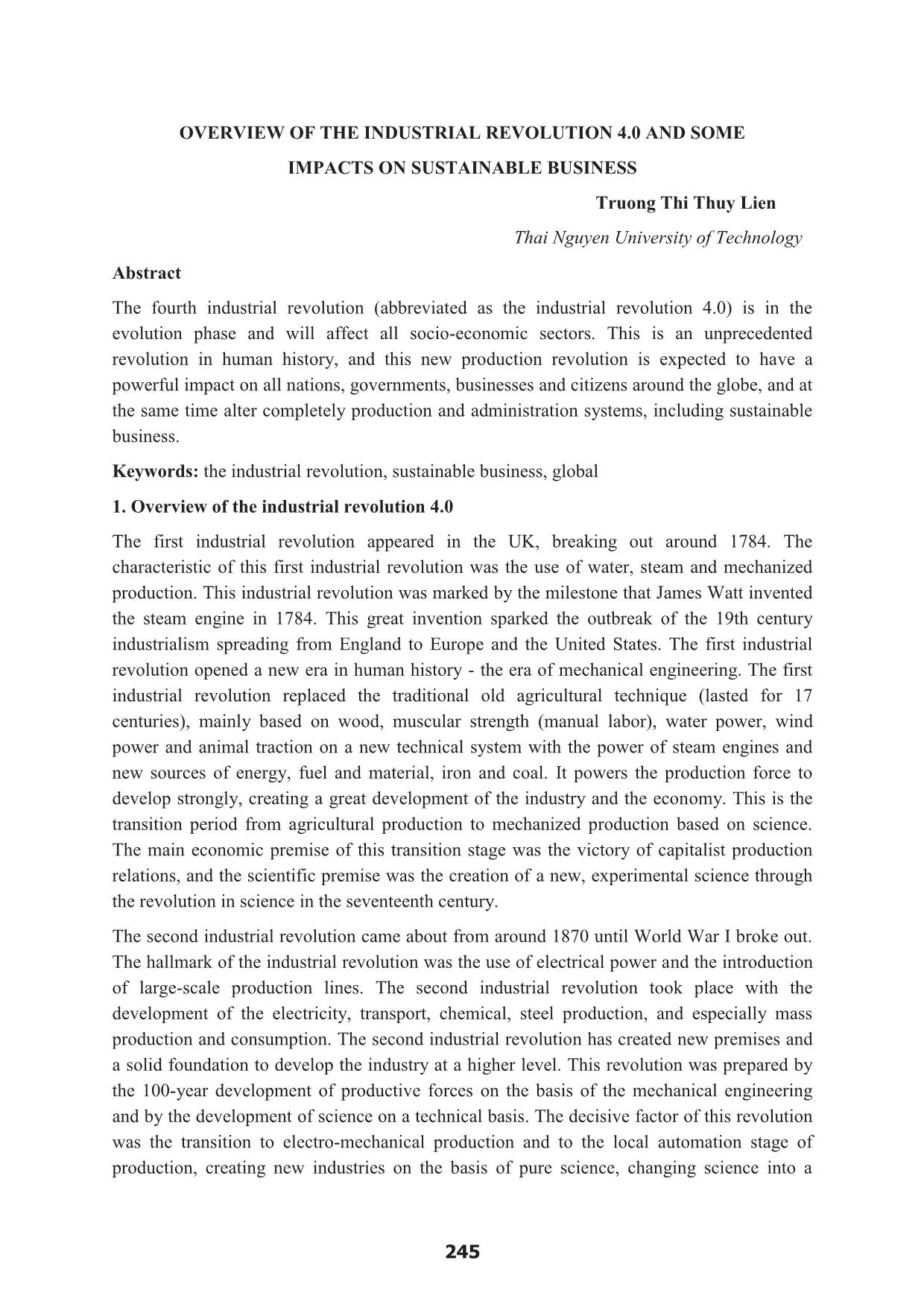
Trang 1
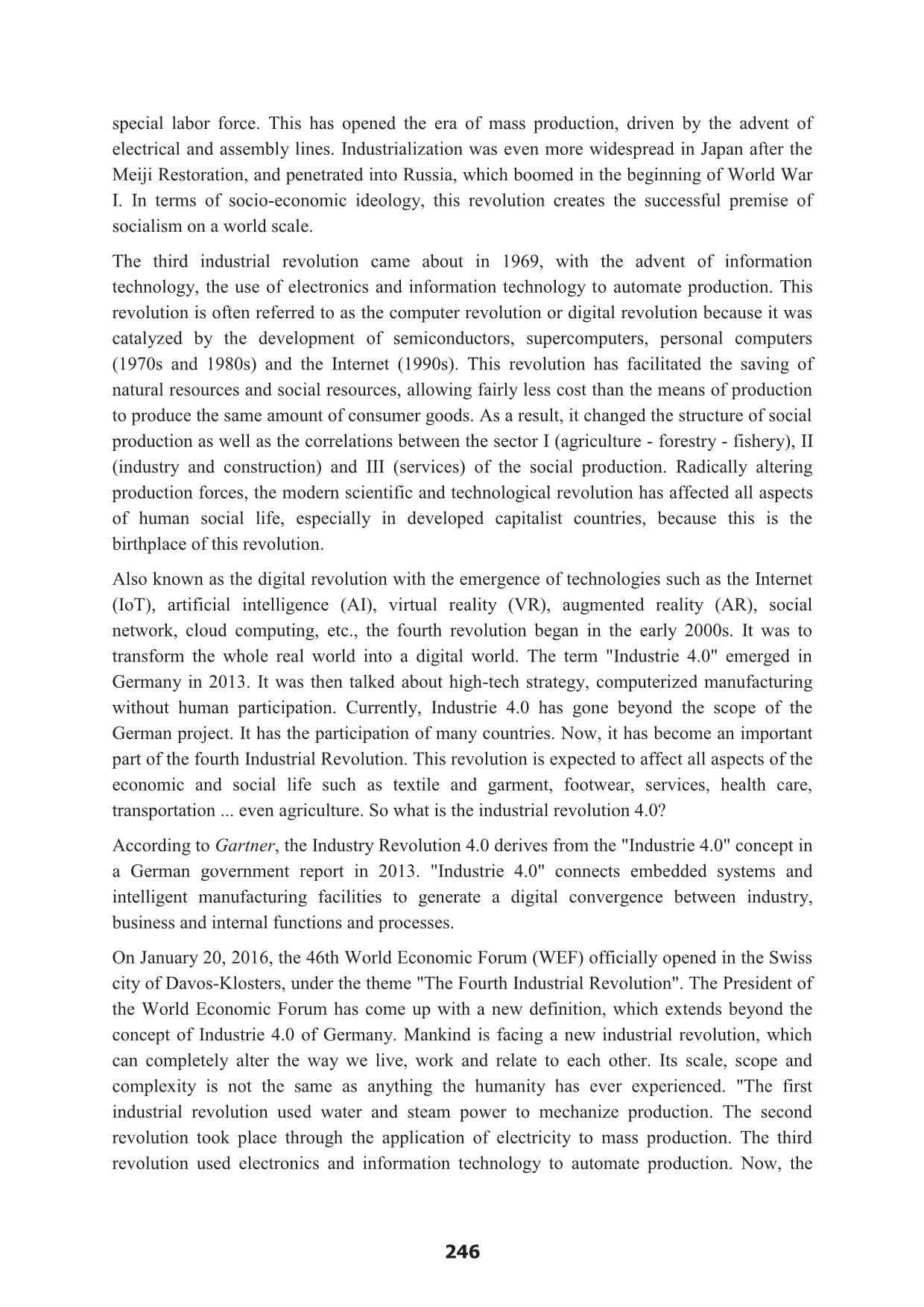
Trang 2
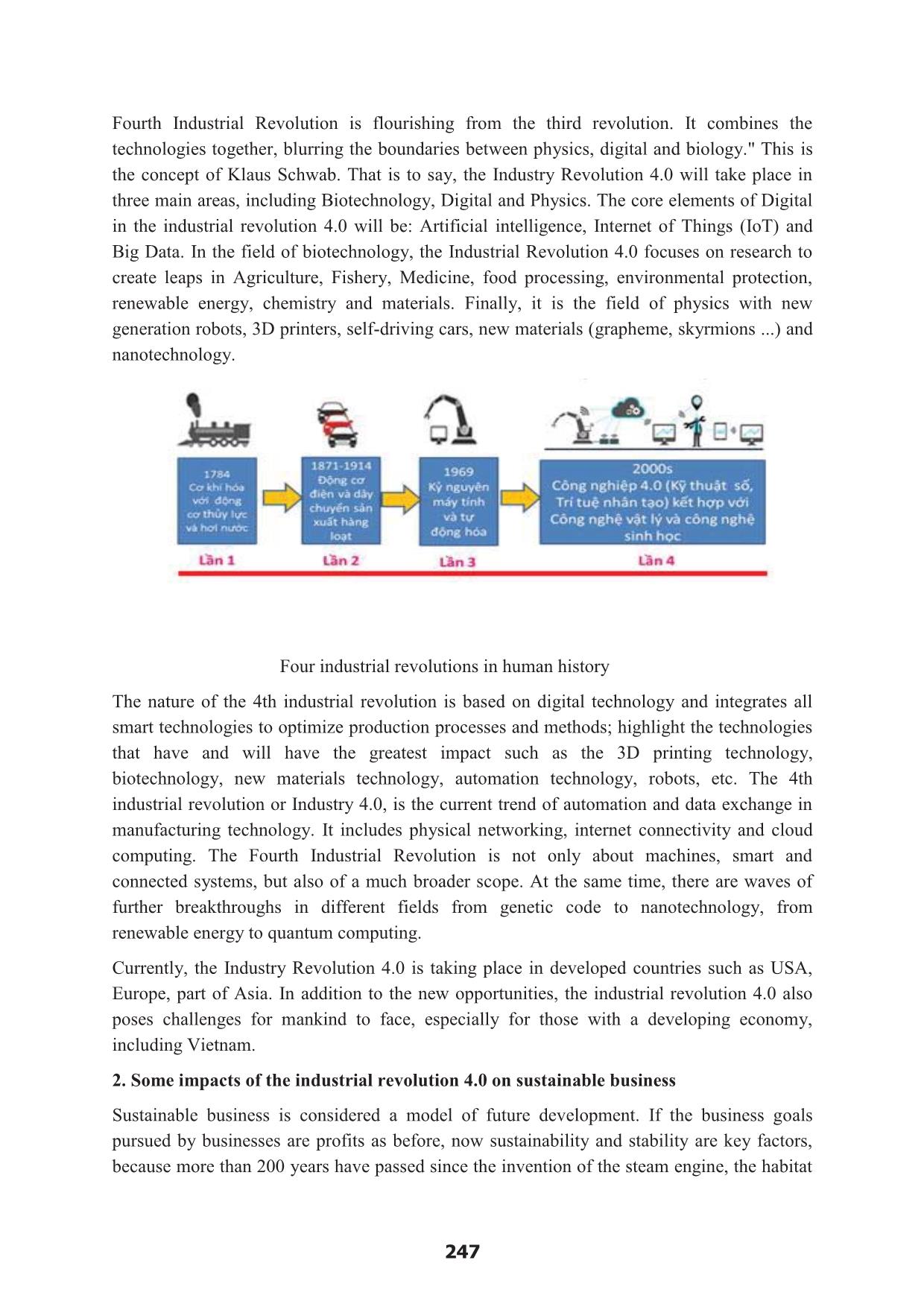
Trang 3
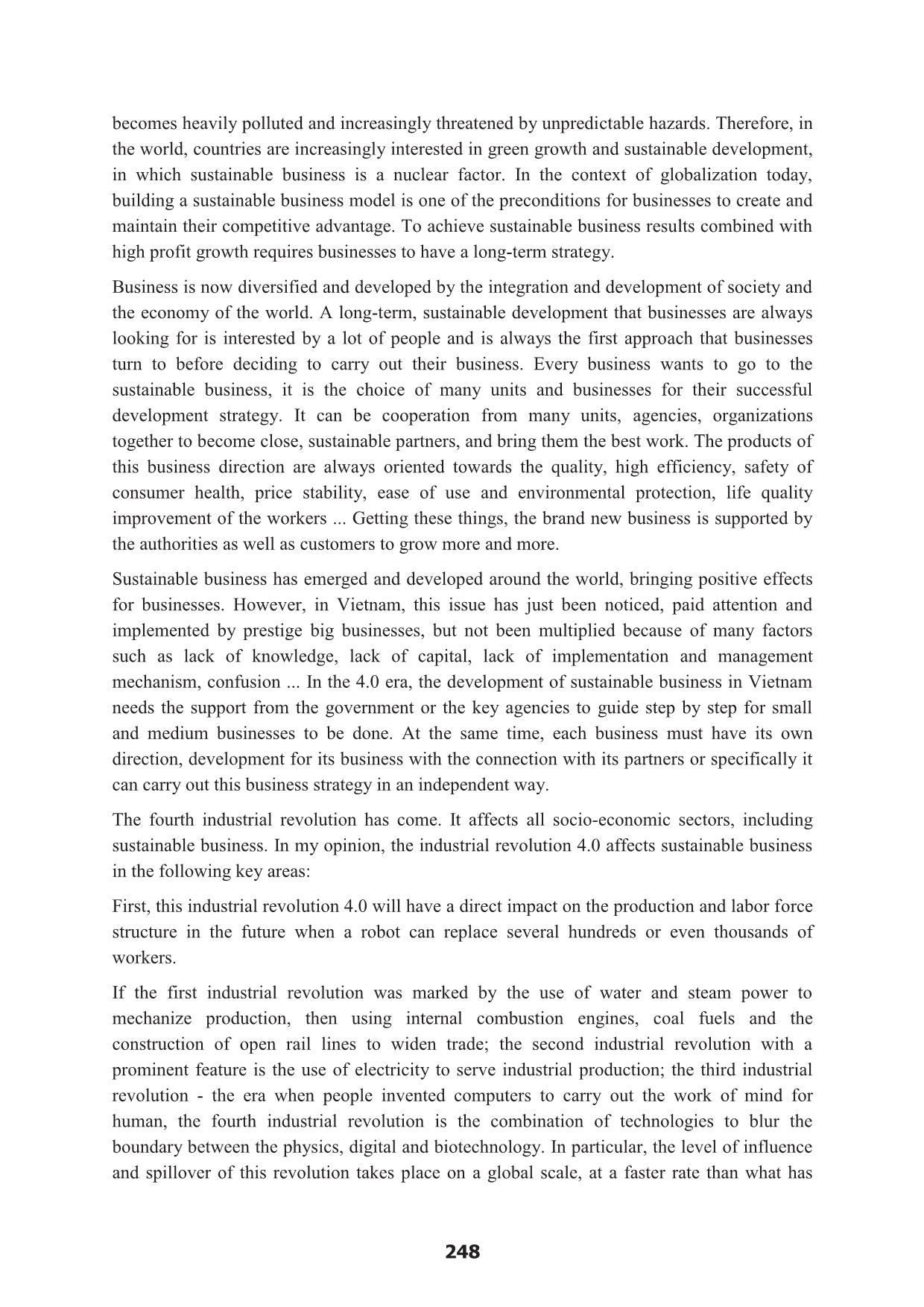
Trang 4
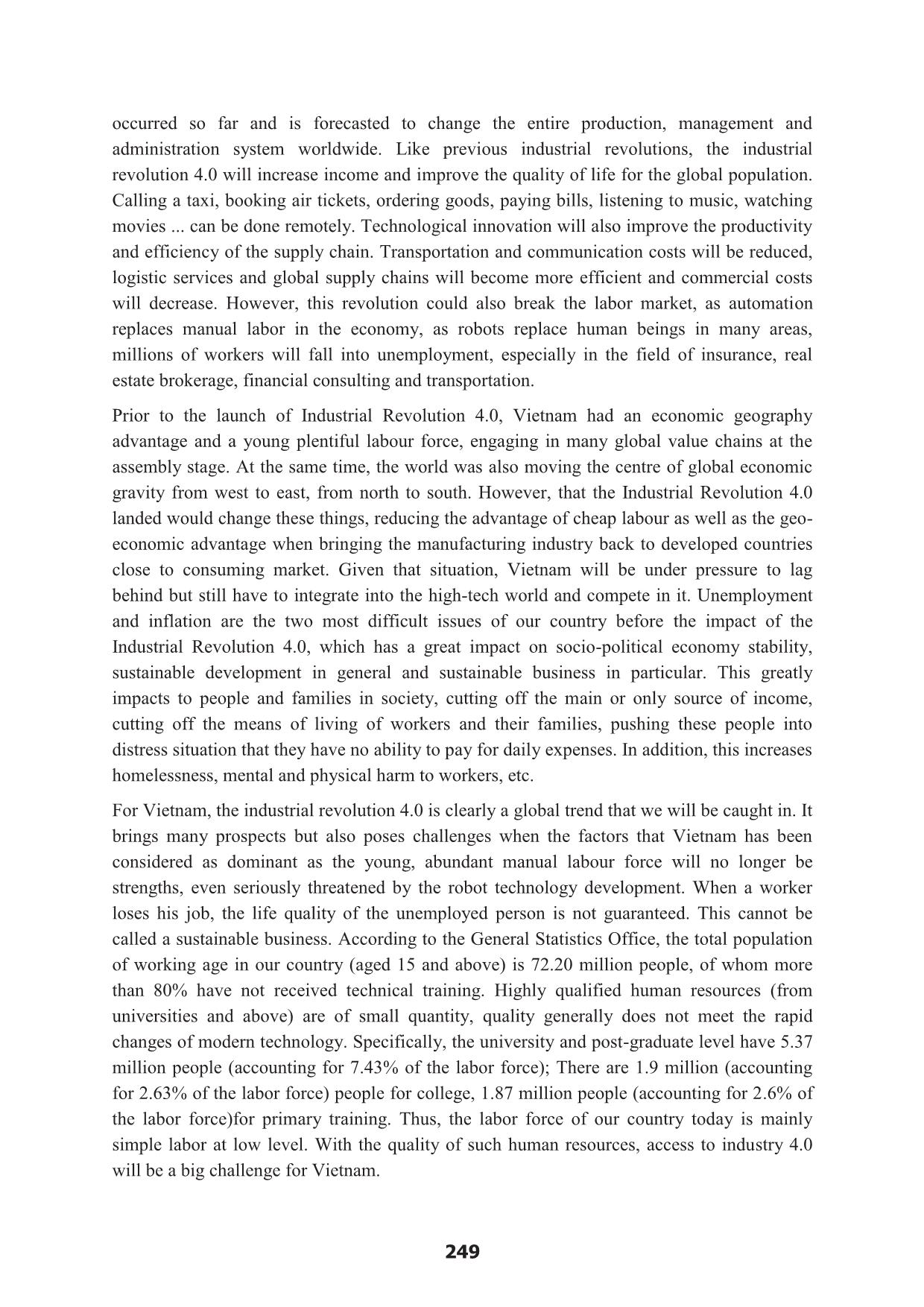
Trang 5
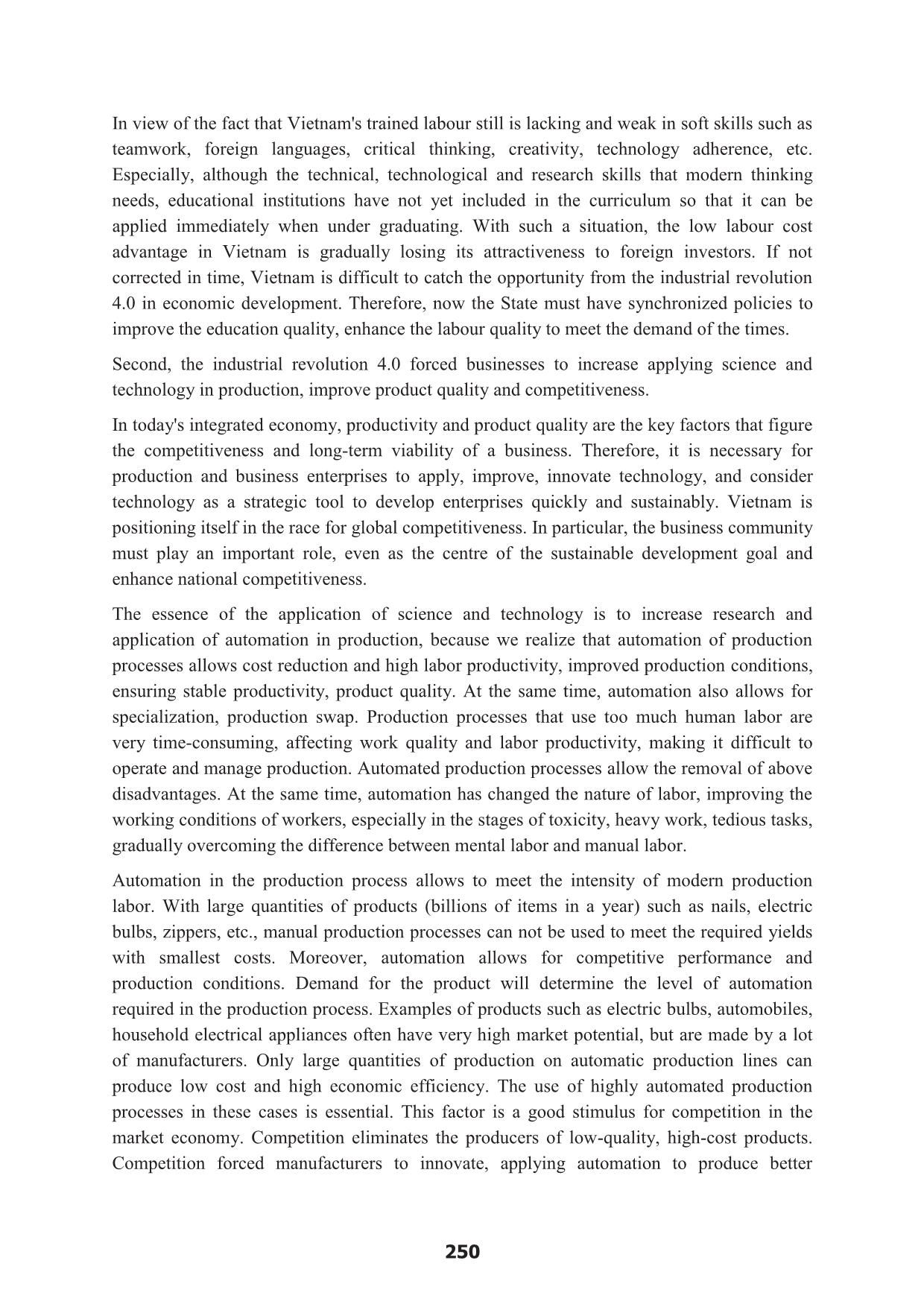
Trang 6
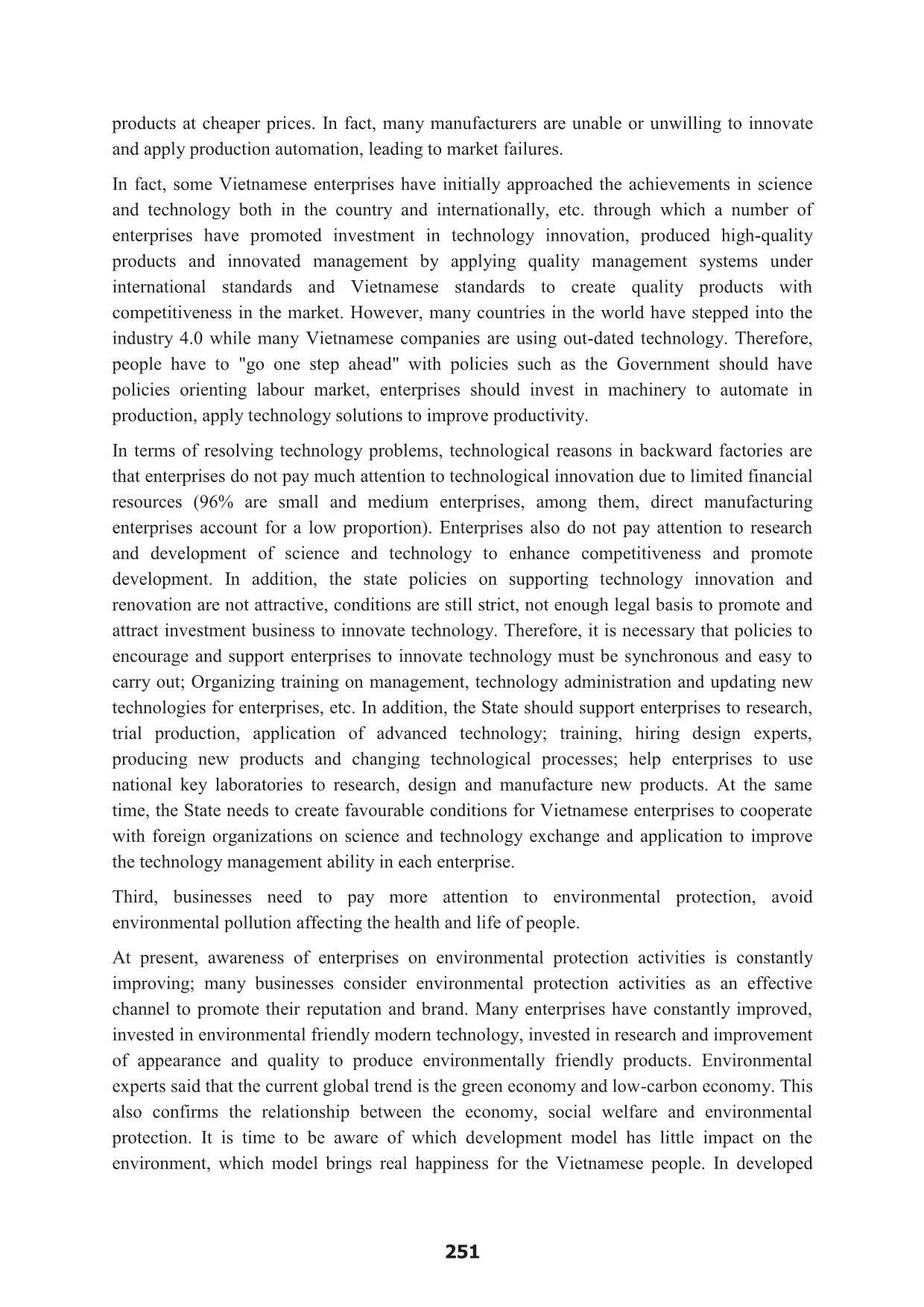
Trang 7
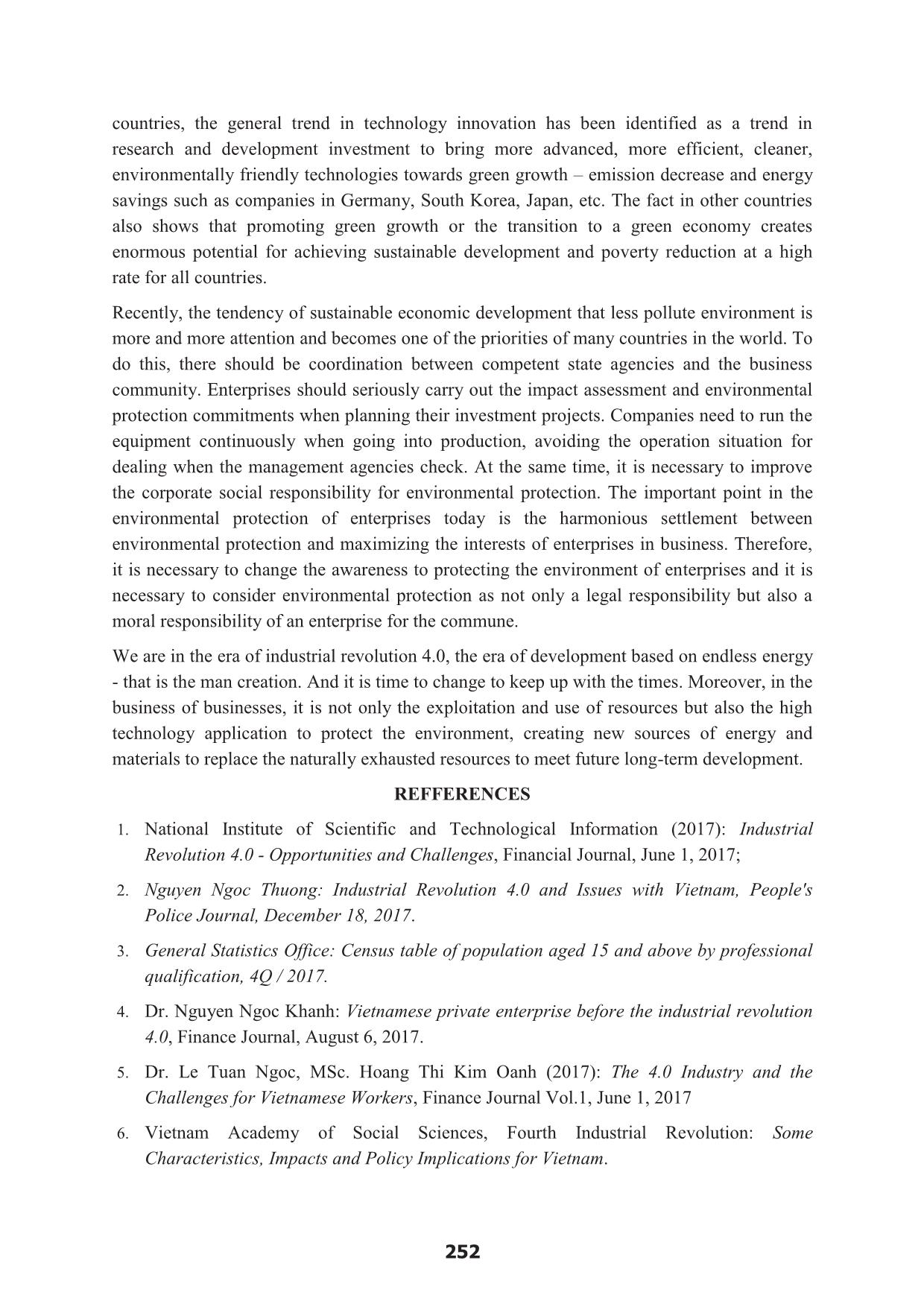
Trang 8
Bạn đang xem tài liệu "Overview of the industrial revolution 4.0 and some impacts on sustainable business", để tải tài liệu gốc về máy hãy click vào nút Download ở trên
Tóm tắt nội dung tài liệu: Overview of the industrial revolution 4.0 and some impacts on sustainable business
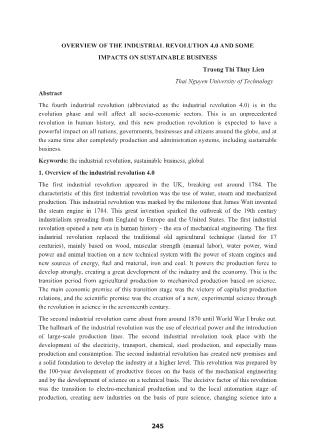
The fourth industrial revolution has come. It affects all socio-economic sectors, including sustainable business. In my opinion, the industrial revolution 4.0 affects sustainable business in the following key areas: First, this industrial revolution 4.0 will have a direct impact on the production and labor force structure in the future when a robot can replace several hundreds or even thousands of workers. If the first industrial revolution was marked by the use of water and steam power to mechanize production, then using internal combustion engines, coal fuels and the construction of open rail lines to widen trade; the second industrial revolution with a prominent feature is the use of electricity to serve industrial production; the third industrial revolution - the era when people invented computers to carry out the work of mind for human, the fourth industrial revolution is the combination of technologies to blur the boundary between the physics, digital and biotechnology. In particular, the level of influence and spillover of this revolution takes place on a global scale, at a faster rate than what has 248 occurred so far and is forecasted to change the entire production, management and administration system worldwide. Like previous industrial revolutions, the industrial revolution 4.0 will increase income and improve the quality of life for the global population. Calling a taxi, booking air tickets, ordering goods, paying bills, listening to music, watching movies ... can be done remotely. Technological innovation will also improve the productivity and efficiency of the supply chain. Transportation and communication costs will be reduced, logistic services and global supply chains will become more efficient and commercial costs will decrease. However, this revolution could also break the labor market, as automation replaces manual labor in the economy, as robots replace human beings in many areas, millions of workers will fall into unemployment, especially in the field of insurance, real estate brokerage, financial consulting and transportation. Prior to the launch of Industrial Revolution 4.0, Vietnam had an economic geography advantage and a young plentiful labour force, engaging in many global value chains at the assembly stage. At the same time, the world was also moving the centre of global economic gravity from west to east, from north to south. However, that the Industrial Revolution 4.0 landed would change these things, reducing the advantage of cheap labour as well as the geo- economic advantage when bringing the manufacturing industry back to developed countries close to consuming market. Given that situation, Vietnam will be under pressure to lag behind but still have to integrate into the high-tech world and compete in it. Unemployment and inflation are the two most difficult issues of our country before the impact of the Industrial Revolution 4.0, which has a great impact on socio-political economy stability, sustainable development in general and sustainable business in particular. This greatly impacts to people and families in society, cutting off the main or only source of income, cutting off the means of living of workers and their families, pushing these people into distress situation that they have no ability to pay for daily expenses. In addition, this increases homelessness, mental and physical harm to workers, etc. For Vietnam, the industrial revolution 4.0 is clearly a global trend that we will be caught in. It brings many prospects but also poses challenges when the factors that Vietnam has been considered as dominant as the young, abundant manual labour force will no longer be strengths, even seriously threatened by the robot technology development. When a worker loses his job, the life quality of the unemployed person is not guaranteed. This cannot be called a sustainable business. According to the General Statistics Office, the total population of working age in our country (aged 15 and above) is 72.20 million people, of whom more than 80% have not received technical training. Highly qualified human resources (from universities and above) are of small quantity, quality generally does not meet the rapid changes of modern technology. Specifically, the university and post-graduate level have 5.37 million people (accounting for 7.43% of the labor force); There are 1.9 million (accounting for 2.63% of the labor force) people for college, 1.87 million people (accounting for 2.6% of the labor force)for primary training. Thus, the labor force of our country today is mainly simple labor at low level. With the quality of such human resources, access to industry 4.0 will be a big challenge for Vietnam. 249 In view of the fact that Vietnam's trained labour still is lacking and weak in soft skills such as teamwork, foreign languages, critical thinking, creativity, technology adherence, etc. Especially, although the technical, technological and research skills that modern thinking needs, educational institutions have not yet included in the curriculum so that it can be applied immediately when under graduating. With such a situation, the low labour cost advantage in Vietnam is gradually losing its attractiveness to foreign investors. If not corrected in time, Vietnam is difficult to catch the opportunity from the industrial revolution 4.0 in economic development. Therefore, now the State must have synchronized policies to improve the education quality, enhance the labour quality to meet the demand of the times. Second, the industrial revolution 4.0 forced businesses to increase applying science and technology in production, improve product quality and competitiveness. In today's integrated economy, productivity and product quality are the key factors that figure the competitiveness and long-term viability of a business. Therefore, it is necessary for production and business enterprises to apply, improve, innovate technology, and consider technology as a strategic tool to develop enterprises quickly and sustainably. Vietnam is positioning itself in the race for global competitiveness. In particular, the business community must play an important role, even as the centre of the sustainable development goal and enhance national competitiveness. The essence of the application of science and technology is to increase research and application of automation in production, because we realize that automation of production processes allows cost reduction and high labor productivity, improved production conditions, ensuring stable productivity, product quality. At the same time, automation also allows for specialization, production swap. Production processes that use too much human labor are very time-consuming, affecting work quality and labor productivity, making it difficult to operate and manage production. Automated production processes allow the removal of above disadvantages. At the same time, automation has changed the nature of labor, improving the working conditions of workers, especially in the stages of toxicity, heavy work, tedious tasks, gradually overcoming the difference between mental labor and manual labor. Automation in the production process allows to meet the intensity of modern production labor. With large quantities of products (billions of items in a year) such as nails, electric bulbs, zippers, etc., manual production processes can not be used to meet the required yields with smallest costs. Moreover, automation allows for competitive performance and production conditions. Demand for the product will determine the level of automation required in the production process. Examples of products such as electric bulbs, automobiles, household electrical appliances often have very high market potential, but are made by a lot of manufacturers. Only large quantities of production on automatic production lines can produce low cost and high economic efficiency. The use of highly automated production processes in these cases is essential. This factor is a good stimulus for competition in the market economy. Competition eliminates the producers of low-quality, high-cost products. Competition forced manufacturers to innovate, applying automation to produce better 250 products at cheaper prices. In fact, many manufacturers are unable or unwilling to innovate and apply production automation, leading to market failures. In fact, some Vietnamese enterprises have initially approached the achievements in science and technology both in the country and internationally, etc. through which a number of enterprises have promoted investment in technology innovation, produced high-quality products and innovated management by applying quality management systems under international standards and Vietnamese standards to create quality products with competitiveness in the market. However, many countries in the world have stepped into the industry 4.0 while many Vietnamese companies are using out-dated technology. Therefore, people have to "go one step ahead" with policies such as the Government should have policies orienting labour market, enterprises should invest in machinery to automate in production, apply technology solutions to improve productivity. In terms of resolving technology problems, technological reasons in backward factories are that enterprises do not pay much attention to technological innovation due to limited financial resources (96% are small and medium enterprises, among them, direct manufacturing enterprises account for a low proportion). Enterprises also do not pay attention to research and development of science and technology to enhance competitiveness and promote development. In addition, the state policies on supporting technology innovation and renovation are not attractive, conditions are still strict, not enough legal basis to promote and attract investment business to innovate technology. Therefore, it is necessary that policies to encourage and support enterprises to innovate technology must be synchronous and easy to carry out; Organizing training on management, technology administration and updating new technologies for enterprises, etc. In addition, the State should support enterprises to research, trial production, application of advanced technology; training, hiring design experts, producing new products and changing technological processes; help enterprises to use national key laboratories to research, design and manufacture new products. At the same time, the State needs to create favourable conditions for Vietnamese enterprises to cooperate with foreign organizations on science and technology exchange and application to improve the technology management ability in each enterprise. Third, businesses need to pay more attention to environmental protection, avoid environmental pollution affecting the health and life of people. At present, awareness of enterprises on environmental protection activities is constantly improving; many businesses consider environmental protection activities as an effective channel to promote their reputation and brand. Many enterprises have constantly improved, invested in environmental friendly modern technology, invested in research and improvement of appearance and quality to produce environmentally friendly products. Environmental experts said that the current global trend is the green economy and low-carbon economy. This also confirms the relationship between the economy, social welfare and environmental protection. It is time to be aware of which development model has little impact on the environment, which model brings real happiness for the Vietnamese people. In developed 251 countries, the general trend in technology innovation has been identified as a trend in research and development investment to bring more advanced, more efficient, cleaner, environmentally friendly technologies towards green growth – emission decrease and energy savings such as companies in Germany, South Korea, Japan, etc. The fact in other countries also shows that promoting green growth or the transition to a green economy creates enormous potential for achieving sustainable development and poverty reduction at a high rate for all countries. Recently, the tendency of sustainable economic development that less pollute environment is more and more attention and becomes one of the priorities of many countries in the world. To do this, there should be coordination between competent state agencies and the business community. Enterprises should seriously carry out the impact assessment and environmental protection commitments when planning their investment projects. Companies need to run the equipment continuously when going into production, avoiding the operation situation for dealing when the management agencies check. At the same time, it is necessary to improve the corporate social responsibility for environmental protection. The important point in the environmental protection of enterprises today is the harmonious settlement between environmental protection and maximizing the interests of enterprises in business. Therefore, it is necessary to change the awareness to protecting the environment of enterprises and it is necessary to consider environmental protection as not only a legal responsibility but also a moral responsibility of an enterprise for the commune. We are in the era of industrial revolution 4.0, the era of development based on endless energy - that is the man creation. And it is time to change to keep up with the times. Moreover, in the business of businesses, it is not only the exploitation and use of resources but also the high technology application to protect the environment, creating new sources of energy and materials to replace the naturally exhausted resources to meet future long-term development. REFFERENCES 1. National Institute of Scientific and Technological Information (2017): Industrial Revolution 4.0 - Opportunities and Challenges, Financial Journal, June 1, 2017; 2. Nguyen Ngoc Thuong: Industrial Revolution 4.0 and Issues with Vietnam, People's Police Journal, December 18, 2017. 3. General Statistics Office: Census table of population aged 15 and above by professional qualification, 4Q / 2017. 4. Dr. Nguyen Ngoc Khanh: Vietnamese private enterprise before the industrial revolution 4.0, Finance Journal, August 6, 2017. 5. Dr. Le Tuan Ngoc, MSc. Hoang Thi Kim Oanh (2017): The 4.0 Industry and the Challenges for Vietnamese Workers, Finance Journal Vol.1, June 1, 2017 6. Vietnam Academy of Social Sciences, Fourth Industrial Revolution: Some Characteristics, Impacts and Policy Implications for Vietnam. 252
File đính kèm:
 overview_of_the_industrial_revolution_4_0_and_some_impacts_o.pdf
overview_of_the_industrial_revolution_4_0_and_some_impacts_o.pdf

